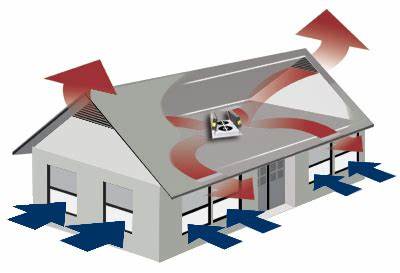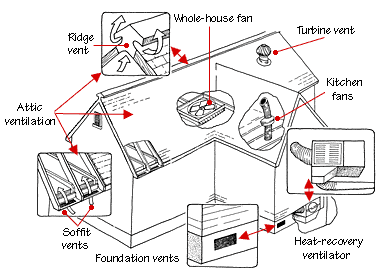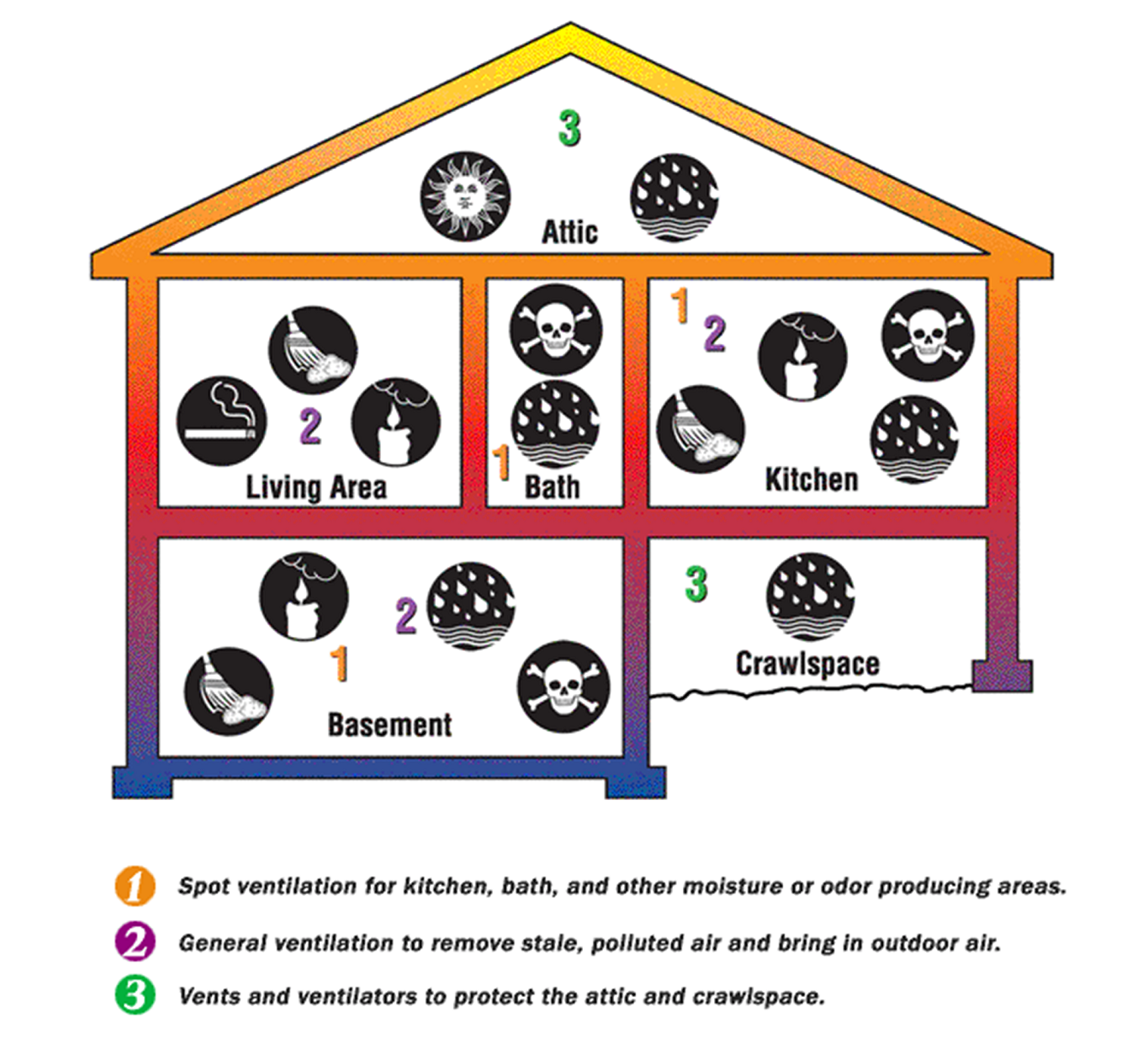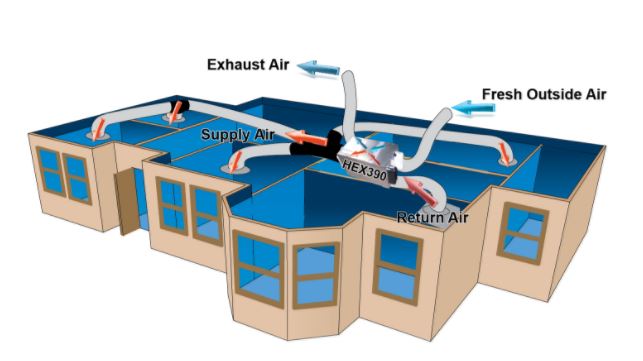Ventilation refers to the exchange of clean air with unclean air in a closed area. In the meantime, home ventilation has receives more attention because without proper ventilation, the house will be full of harmful pollutants.
Why Ventilate?
Suppose a house without ventilation, then numerous pollutants, such as ammonia, carbon monoxide, nitrous oxides, and sulfur dioxide. These pollutants can be supplied from both inside and outside of the house.
Gases from combustion appliances, like fireplaces, stoves, and barbeques, are prominent examples of indoor pollutant sources. The generation of such gases can accumulate in a poorly ventilated home and threaten the safety and health of residents. Besides, the existence of ample moisture in the home can also threaten the health, i.e. it can cause mold growth, structural damage to the house, and even corrupt insulation. Furthermore, high levels of moisture can lead to a higher load on cooling equipment, which leads to higher energy bills.
There are also multiple sources of outdoor pollutants, such as cars, motorcycles, and power plants. Thus, the proposed outdoor air must be ventilated prior to the replacement with the indoor air.
Ventilating a home joins the house’s physical aspects with procedures you can perform after the construction phase. Ductwork and exhaust fans can eliminate combustion gases from home. Additionally, there are many ways you can block moisture from penetrating and accumulating in your home.
3 Major Types of Ventilation
Commonly, three types of ventilation are proposed:
Natural ventilation
Natural ventilation is free air passage from doors, windows, or even cracks in the home. This type of ventilation used to be the most frequent ventilation method for allotting fresh outdoor air to replenish indoor air in a house yet is ascertained in most older homes.

Spot ventilation
Spot ventilation regulates air movement by employing localized exhaust fans to eliminate pollutants and moisture at the source immediately. Prevalent household examples include range hoods over cookers and bathroom exhaust fans. Spot ventilation is typically utilized in conjunction with one of the other strategies and can enhance natural ventilation effectiveness. If both spot and natural ventilation concurrently do not meet your home’s ventilation demands, then one should reconsider a whole-house ventilation approach.
Whole-house ventilation
Whole-house ventilation involves employing one or more fans and duct systems to exhaust musty air and/or supply clean air into the home. Whole-house ventilation systems present controlled, stable ventilation throughout the house. They may be supply-only (depending on air leakage from the house to exhaust stale air), exhaust-only (relying on leakage into the building for pure air), or balanced systems, including exhaust and fresh air intake elements.

The Benefits of a Good Ventilation
The primary benefit of adequate home ventilation is to purify an unhealthy environment, resulting from common pollutants from people, activities, pets, materials employed to build and furnish the house, and excess moisture from insufficient ventilation. Millions of single-family homes around the world can experience high rates of air quality dilemmas.
Designing an appropriate home ventilation system requires identifying various sources of pollutants inside the house. These pollutants are generally designated as moisture, household chemicals, particles, tobacco smoke, combustion products, and heat.
Moisture
The excess moisture inside a house can cause some health problems to those who have an allergy by encouraging the development of mildew, bacteria, dust mites, and insects. It can also create structural damage by promoting the growth rate of molds and dry rot.
Household chemicals
The household chemicals include paint and solvents, pesticides, cleaning supplies, volatile organic components, odors. Each of the mentioned components can cause allergy problems to sensitive persons, and stronger chemical supplies can even cause severe issues to healthy persons. Hence, a proper ventilation system in every house is essential due to the ample daily use of the mentioned chemicals.
Particles
So many particles are produced in a house in the shape of dust, pet dander, lead, pollen, and asbestos every day. The accumulation of such particles and exceeding a specific value can also cause health-related problems.
Combustion products
As discussed earlier, fuel-burning products such as heating equipment, fireplaces, stoves, gas water heaters, gas ranges, and candles produce multiple pollutant products, which are essential to eliminate from a house.
Heat
Overheating is a common process that happens in attics due to the long exposure of summer sunshine. Thus, attic ventilation systems are designed to remove both excess heat and relative humidity to provide comfort and a healthy spot in a home.

Strategies for designing home ventilation systems
The indoor air quality of a hose can be significantly increased using an Energy Recovery Ventilator (ERV) or a Heat Recovery Ventilator (HRV). A quality ventilation system contributes to protecting the home’s structural integrity, diminishing maintenance charges, and appending its value. The strategies involve:
- Intermittent local ventilation, which is often employed for bathrooms, kitchen, and other areas with the source of producing moisture and/or odor and contaminant-producing.
- Continuous whole-house ventilation, which is used to eliminate polluted air and provide fresh air throughout the home.
- Attic and crawlspace ventilation, which, as the name implies, is related to protect attics and crawlspace.
Strategies to improve home ventilation
Some preliminary tips can considerably improve ventilation performance in a home. We have listed down some as follow:
Open doors and windows
This simple tip might look like a no-brainer to some, but many people frequently overlook open doors or windows to let fresh air in and force stale air out. Merely opening doors and windows a few times throughout the day to “air out” your home quickly replenishes musty indoor air with fresh outdoor air, getting rid of pollutants, excess moisture, and allergens.
Dry the laundry outside
This is an unforgivable action to do the laundry and wiping the clothes indoors, and there are several legitimate reasons for that. We can accuse the changeable weather (especially in winter). Nevertheless, drying wet clothes inside our homes produce condensation and restrict your heating system from running efficiently. It also expedites condensation and mold extension in winter.
It is always more beneficial to dry your clothes in a sheltered outdoor area to resolve this dilemma, so your clothes can dry while lingering out of range of rain. If drying laundry indoors is the only choice you have, make sure at least your windows are open to let the excess moisture get away.
Ventilate rooms overnight
Leaving windows slightly half-open overnight can increase the room’s air quality while also diminishing excess moisture and mold growth risk. In summer, this absolutely assists with decreasing the humidity levels to get a night of better sleep. Still, it would be best to be more cautious about ventilating in winter because you don’t want too much heat to emerge in the process.
Install extractor fans and attic vents
Extractor fans and attic vents are both functional ventilation systems that service specific areas in the home. Extractor fans that release out into the open air should be placed in kitchens, laundries, and bathrooms – these are the fundamental areas where moisture and musty air build up much faster. Attic vents dispossess the excess heat and humidity that get trapped in the attic, aiding your home’s central ventilation system in the process.
Consider a home ventilation system
A well-designed and well-installed home ventilation system contributes to excellent ventilation, notwithstanding what the weather is like outdoor, which is an exceptional option to merely opening doors and windows. A home ventilation system such as the Energy Recovery System (ERS) can replace spoiled air in your home with a fresh one, dry air to produce a healthier, drier, and more passionate living atmosphere for your family that is much easier to heat.



